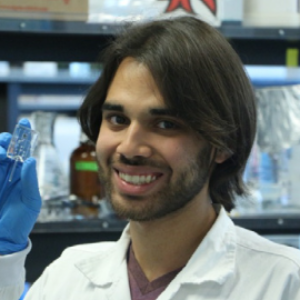Title : Evaluation and characterization of neural integration within polymeric scaffold aiming spinal cord regeneration
Abstract:
Tissue therapy in cases of spinal cord injury is of great importance for the development of treatments aimed to nerve regeneration. One of the main methods is the use of polymeric scaffolds, which are structured biomaterials that promote cell support and stimulate cell differentiation at injured sites. However, cellular responses may vary according to the macro and microstructure of these materials. Regarding macro configurations, one can obtain scaffolds ranging from films, cylinders, tubes, channels, and even hydrogels. In addition, the microstructural conformations may be unique, allowing variations in the mean pore diameter, hydrophilicity, composition and other surface characteristics of the biomaterials. However, these properties should be evaluated in vitro before proceeding to the in vivo application.
Objectives: The aim of this study was to evaluate and characterize the cytotoxicity and development of spinal cord cells in contact of polymeric biomaterials films based in chitosan (CHI); poly-L-lactic acid (PLLA); polycaprolactone (PCL) and f ibrous polycaprolactone (PCLf) for spine regeneration.
Methods: The sterilization method used was ultraviolet (254 nm, 30 minutes) on each side of the biomaterial. With each polymer were performed: a) VERO cell cultures for cytotoxicity analysis, through direct and extract contact, in addition to MTT tests; b) mixed primary cultures of spinal cord of neonatal rats with 0-3 days postnatal (P0-P3) for evaluation of fixation, cytotoxicity, differentiation, dendritic branching and connectivity through light microscopy and transmission electronics. All experiments were carried out according to protocol 4509160816 approved by CEUA/UFABC.
Results and Conclusions: Based on the cell viability assays (MTT test), it was observed that the PCL (1.067±0.013), PCLf (1.089±0.028), PLLA (1.169±0.066) and CHI (1.068±0.014) composites obtained similar results to the negative control (1.000±0.042) , where the cells developed properly within 24 hours after incubation, demonstrating no cytotoxicity. With the result of non-cytotoxicity of the polymers, the cells of the spinal cord of neonates were incubated on them, allowing observations on the differentiation and development of this culture in direct contact with the biomaterials. In comparison to the negative control, the biomaterials resulted in similar morphologically cells. With all of this in mind, we suggests that the polymeric films of PCL, PCLf, PLLA and CHI allow adhesion and correct differentiation for both Vero cell lines and spinal cord cells. Thus, all the information suggests that the use of scaffolds may be a great alternative for spinal regeneration. Key-words: cellular viability, spinal cord injury, scaffolds, biomaterial.



